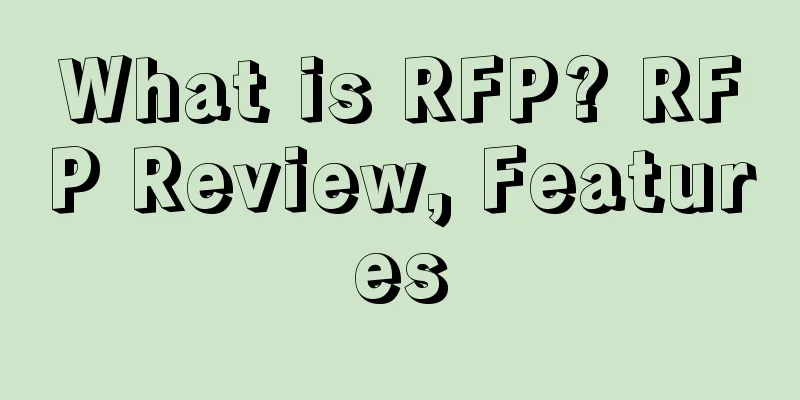What is RFP? RFP Review, Features

|
RFP (Request For Proposal) is a comprehensive and detailed statement to the service provider from the customer's perspective about the preparations that should be made to meet the identified needs. In other words, the RFP is a proposal issued by the customer to the service provider to explain how to meet the identified needs. It is the first written document for the customer to establish formal contact with the service provider, also known as a tender document.
About RFP ·RFP is usually drafted by the customer, mainly describing the customer's needs, conditions and specific requirements for the project tasks. A complete RFP mainly includes the work description of the project that meets its needs, project requirements, expected project goals, customer supply terms, payment methods, contract form, project time, project application requirements, etc. A good demand proposal allows the service provider to accurately grasp the products or services that customers expect. Of course, it is not necessary to prepare a formal demand proposal in all cases. When the needs of a company are met by internal development projects, the process seems to become much simpler. At this time, what is needed more is verbal communication and information transmission, rather than wasting precious time on demand proposals that only serve to transmit information. For example, when a software development company feels that the company's original financial analysis system is far from meeting the increasing business needs, it can directly ask the software development team to develop it. At this time, it only needs to verbally convey the relevant requirements to the software development team.
Writing requirements When writing an RFP, you must be responsible and serious, with specific content and concise language. It must meet the following requirements: 1. Write the word “Proposal” in the middle of the first line. 2. Write the name of the person who will accept the suggestion. 3. Main text: (1) The reason or starting point for the suggestion, which is convenient for the other party to consider. (2) Specific matters proposed. 4. Express the wishes of the proposer. 5. Write words of respect at the end, such as "Best regards" etc. 6. Write the name of the proposer and the date the proposal was written.
Format structure 1. Title. 2. Title. 3. Main text (introduction, main body, conclusion). 4. Signature and time.
Guidelines The RFP must state the project objective or purpose, including any reasonable information or background information that may be useful to the contractor so that the contractor can prepare an appropriate proposal. The following guidelines are used to draft a formal RFP: 1. A Statement of Work (SOW) must be provided. 2. Customer requirements must be included to define specifications and attributes. 3. It should state what deliverables the customer expects the contractor or project team to provide. 4. Any items to be provided by the customer should be listed. 5. Explain the content that requires customer approval. 6. It can indicate the type of contract the customer wishes to adopt. 7. You can indicate the payment method the customer wishes to use. 8. Indicate the schedule required to complete the project. 9. Provide guidance and explain the format and content of the contractor’s application. 10. Indicate the deadline by which the client expects potential contractors to submit their applications. 11. Can include evaluation criteria.
necessity RFP is a requirement specification prepared by the customer to ensure that the supplier understands the project requirements and provides a project proposal based on this. Although it cannot ensure that the customer can obtain the ideal solution based on this, it can help the customer find the system preparation that is as close to their own needs as possible. Its purpose is to start from the customer's own perspective, through a comprehensive and detailed statement, so that the developer or project team understands what the customer wants and meets the customer's identified needs at a feasible price. For some clients with smaller budgets, developers are often reluctant to spend time preparing a formal proposal. In this case, the client's demand proposal becomes very important. In fact, no matter how big or small the project is, it is necessary to write a demand proposal. 1. RFP needs to describe the user's goals and needs. The process of preparing a demand proposal is also a process for customers to further clarify their goals and needs, and thereby build a bridge for in-depth communication between customers and suppliers. 2. The RFP can save time in selection and make it easier to compare suppliers. The information provided by the customer to all bidding suppliers is the same, avoiding repeated communication with each developer. At the same time, with the RFP as a benchmark, the customer can constrain each developer to submit a proposal in a consistent format to improve the comparability between suppliers. 3. RFPs can avoid potential omissions. When preparing a RFP, clients often overlook some important factors because they are too focused on specific details. After receiving the RFP, some suppliers may proactively question such omissions to remind clients. Some developers may even propose some good ideas that are not included in the RFP to expand clients' thinking in order to make their proposals more attractive.
General Principles The requirements proposal should be written by the user, but due to various objective factors, it is difficult to do so. Therefore, it is often written by the user and the project team together. There is no formulaic method for writing an excellent project requirements proposal, and a lot of practical experience is required. The following are several principles to grasp when writing a requirements proposal: 1. Requirements should be correct. Each requirement must accurately describe the functionality to be delivered. 2. Requirements should be feasible. The requirements of the project should be achievable under limited resources (known capabilities, limited systems and their environment). 3. The requirements should be necessary. Each requirement in the demand proposal should have a corresponding source. 4. Requirements should have priority. Priority is established by the client or its agent and the project team after consultation. Generally, there are three levels of priority: high priority; medium priority; low priority. 5. Requirements should be clear. Requirements should not be ambiguous. Avoid using words that are clear to the person drafting the project requirements proposal but vague to others.
Example For example, the Federal Railroad Administration (FRA) issues a call for proposals to finance, design, build, operate, and maintain a high-speed rail (HSR) system. Interested parties submit proposals that meet the documentation requirements. Based on the proposals received by the deadline, the Department of Transportation (DOT) establishes committees to further review and develop the proposals. DOT selects the proposal that best meets its goals and hires a company to do the work. |
<<: What is Shopswain? Shopswain Review, Features
>>: What is RFI? RFI Review, Features
Recommend
What is Negative keywords? Negative keywords Review, Features
Negative keywords are a great way for Amazon sell...
What is EasyYa? EasyYa Review, Features
EasyYa is a service platform under YiChuang that ...
What is Hai Mi Pie? Hai Mi Pie Review, Features
Haimipai is an innovative company focusing on cros...
Huawei team takes over! Overseas brands take the first place in market share
With the rapid advancement of technology and the ...
What is 10客? 10客Review, Features
Yilingke (Yilingke Technology Co., Ltd.) was estab...
Amazon's fourth quarter advertising report is out
Perpetua, an e-commerce advertising optimization ...
What is Fusionzoom? Fusionzoom Review, Features
Fusionzoom (Ark) ERP is affiliated to Shenzhen Yi...
What is Star Business? Star Business Review, Features
Founded in 2011 and headquartered in Shenzhen, Xin...
Found a large traffic entrance climate green label! A large number of Amazon sellers have seen a surge in orders
As a cross-border e-commerce platform giant, Amaz...
Ranked in the top five in the category in 45 days! Sellers share their experience in creating a hit product on Amazon
From top sellers to small and medium-sized seller...
What is White Whale Out to Sea? White Whale Out to Sea Review, Features
BaiJing Chuhai is a comprehensive service platform...
US court issues another TRO to stop infringement on Shein, 31 sellers’ funds frozen
Shein's rights protection for its own brand w...
Google sues India's antitrust regulator over leaked probe report
According to Reuters, Google said on Thursday tha...
What is Qianya Maijia? Qianya Maijia Review, Features
Shanghai Qianya International Freight Forwarding C...
After working alone for three months, Amazon operations became a worker again
It is said that the end of Amazon is to work alon...









